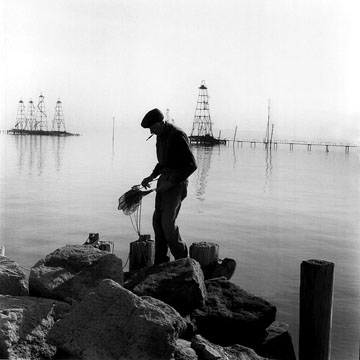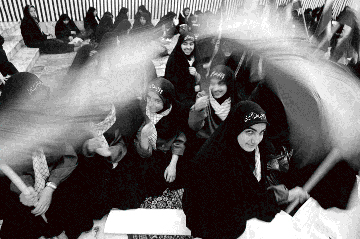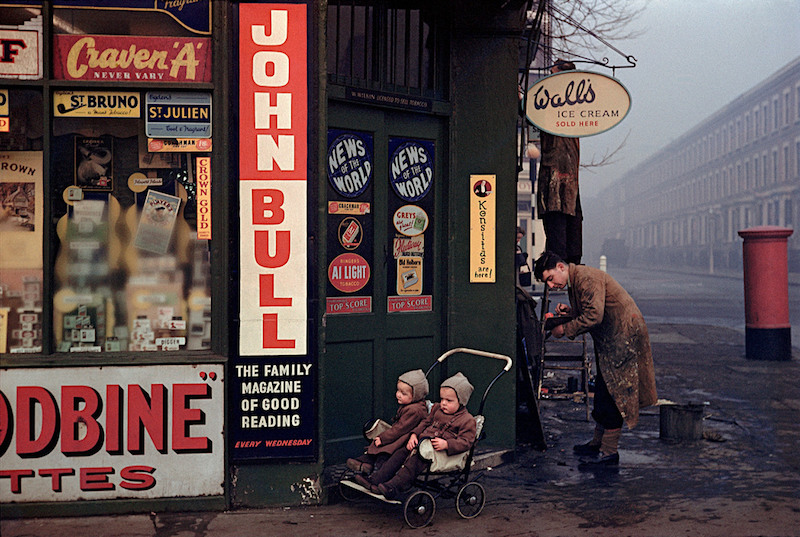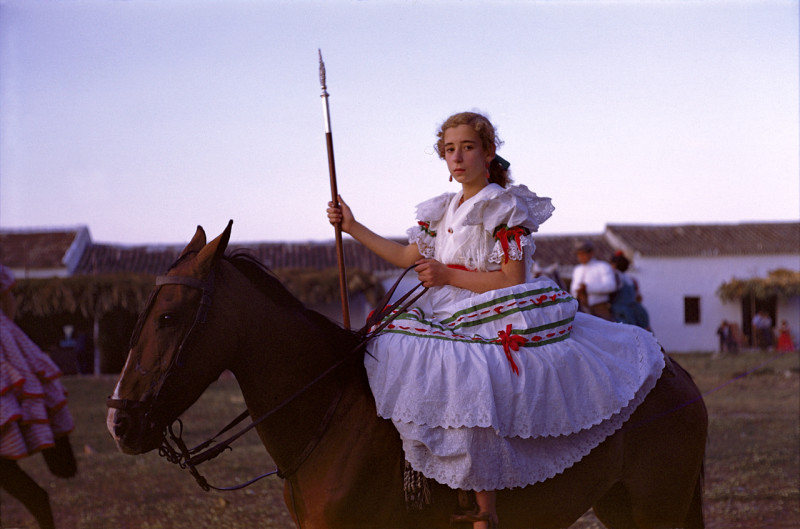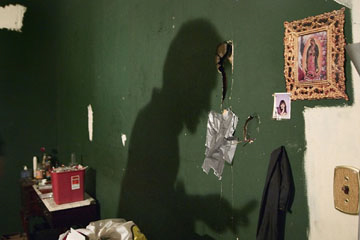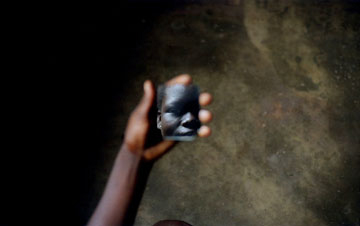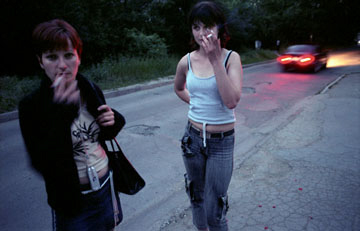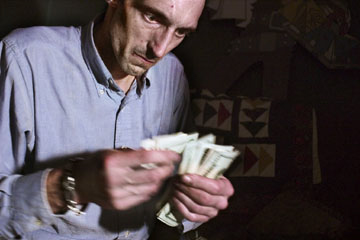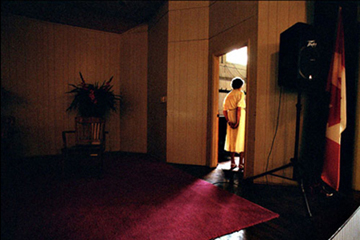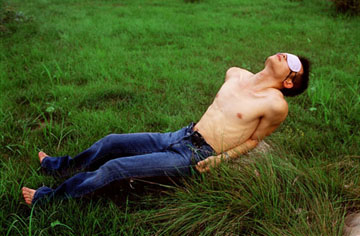Inge Morath: First Color
Afterword by John P. Jacob, Inge Morath Foundation.
From Inge Morath: First Color, Göttingen: Steidl, 2009.
Please also see the slideshow.
Inge Morath’s achievements, during the early years of her career as a photographer, were significant. After an apprenticeship in London with Simon Guttman, founder of the legendary Dephot Agency, followed by two years as a researcher and assistant to Henri Cartier-Bresson, in 1955 Morath was the first woman to become a full member of Magnum Photos. ((Morath came to Mangum in 1949, as a researcher and editor. She relocated to London in ‘51, and began her apprenticeship with Guttman around that time. Morath was likely introduced to Guttman by Robert Capa, who had learned photography from him in the early 1930s. It was certainly Capa who suggested that Morath train with Cartier-Bresson during her first years as a Magnum photographer. Eve Arnold was the first woman to become associated with Magnum as a photographer, in 1951, but she did not join as a full member until 1957.)) Like many of her Magnum colleagues, Morath was motivated by a fundamental humanism, shaped as much by the experience of war as by its lingering shadow over post-war Europe. This motivation grew, in Morath’s mature work, into a motif, as she documented the endurance of the human spirit under situations of duress and transformation. If a thread can be said to run through her work from beginning to end, it is the marvel of human creativity, which Morath both recorded and exemplified in her photography. Throughout her career, publishing was the primary means by which Inge Morath sought to reach her audience. In all, Morath published more than thirty monographs, as well as numerous anthologies and, in keeping with her work as a photojournalist, stories in a wide variety of picture magazines. From an historical perspective—contrasting whole bodies of pictures with their highly edited, published counterparts—the breadth of Morath’s publishing activity provides key insights into the ways that she thought about her work, both as individual images and as an oeuvre spanning fifty years. An overview of Morath’s publications is particularly revealing in relation to her work in color.
For the purposes of such an overview, Morath’s career may be divided into three periods, each coinciding with significant—and significantly different—publishing activities. Morath’s short, early period, from the mid-1950s until she relocated to the United States in 1962, coincides with the “classic” era of modern photography magazines and books, when the published image took on equal or greater importance in relation to its accompanying text. Her description of this period as “the time of big stories and far-flung trips” ((Morath, Inge, in Berlin Lecture. Undated manuscript, Archives, Inge Morath Foundation, New York, p. 26.)) is reflected in the subjects of her first two monographs, Guerre a la Tristesse (1955) and De la Perse a l’Iran (1958), edited and published by Robert Delpire, himself a pioneer of photographic publishing. ((The English language editions of Morath’s first two books were published as Fiesta in Pamplona (1956) and From Persia to Iran (1958). In 1961, together with photographers André Martin and Marc Riboud, Morath also contributed to Delpire’s anthology Tunisie: De Carthage à demain.)) Morath’s middle period, from the early ‘60s through the mid-1980s, is defined by long-term international projects, notably her three collaborations with her husband, playwright Arthur Miller, In Russia (1969), In the Country (1977), and Chinese Encounters (1979). The second of these is particularly interesting as a document of Morath’s rather cool observations of her adoptive homeland. In this period too, following a lifelong interest in portraiture, Morath published Inge Morath: Portraits (1986) with Aperture Books, and edited the anthology Paris: Magnum Photographs 1935 – 1981 (1981), also for Aperture. In her extraordinarily productive late period, from the mid-1980s until her death in 2002, Morath returned to several of her important early projects. In Donau (1995), for example, she revisited and completed a body of work begun in the late ‘50s, documenting the Danube River from source to end, while in Venezia (2003), she revisited the work done for her book Venice Observed (1956), with writer Mary McCarthy. Russian Journal (1991) greatly expanded upon Morath’s earlier book with Arthur Miller, In Russia, and Saul Steinberg Masquerade (2000), perhaps the best known of Morath’s many books, saw the long-awaited publication of her collaboration with Steinberg during the late ‘50s and early ‘60s. Morath’s late period is also notable for two important publishing partnerships. Working with the Spanish editor and curator Lola Garrido, Morath produced three books of her extensive early work in Spain: Inge Morath: España Años 50 (1994), San Fermin Años 50 (1997), and Camino de Santiago (1998). And, working with two Austrian colleagues, photographer Kurt Kaindl and editor Brigitte Blüml, Morath produced a series of books bringing together old and new work on a variety of subjects, including the aforementioned Donau and Venezia, as well as New York (2002) and Durch Österreich (2005). ((Durch Österreich, roughly translated as in, or through, Austria, was begun before Morath’s death and published posthumously.)) Morath, Kaindl, and Blüml also produced a major retrospective monograph, Inge Morath: Fotografien 1952 – 1992 (1992), and a second book of portraits in 1999. In her final book, Last Journey (2003), Morath, accompanied by the German filmmaker Regina Strassegger, returned the Austrian/Slovenian borderland of her childhood to document its historically and politically contested ground and communities. Of all her publications, Last Journey is the most explicit in its acknowledgment that Morath recognized herself as a participant in the larger historical document comprised by her photography. The project suggests that a further turning point in her career, in which Morath at last brought together her photographs with the extended texts that she so often wrote about her subjects, was cut short by her untimely death. ((Having begun at Magnum as a researcher and caption writer for other photographers, throughout her own career Morath wrote extensive texts about her subjects. From the 1950s and ‘60s these include anecdotal notes—such as her nine typed pages on obtaining an audience with the British royal family in 1954—as well as biographical, geographical, and cultural research. After the 1960s, Morath also wrote extended journals; during her first visit to China, in 1978, she typed over 200 pages. In her later years, Morath wrote a collection of biographical sketches of many of the subjects of her portraits. In an interview with the author (March 27, 1008, in New York), Morath’s friend and neighbor, Tom Cole, noted that towards the end of her career she was especially eager to find a way to successfully bring her words together with her pictures.))
Color photography, while not entirely missing from Inge Morath’s publications, appears only in a handful (eight of the twenty listed here), and then, with the notable exception of De la Perse a l’Iran, sparingly. ((The titles listed here which contain color images, and the proportion of color pages in relation to the total pages in each, are: Guerre a la Tristesse (17/148), De la Perse a l’Iran (35/69), In Russia (14/240), In the Country (8/192), Chinese Encounters (15/255), Russian Journal (21/132), Donau (30/143), and New York (19/181). This is highly unscientific, as the figures for total pages include blank, text, and picture pages, while color pages include many single-image two-page bleeds. Nevertheless, it offers a good overview of the relatively small space allotted to color in Morath’s books. De la Perse a l’Iran is the exception. One reason for this, recently discovered, is that a light leak in Morath’s camera caused significant damage to many of her black and white negatives in Iran. Also, as historian Inge Bondi has written in a letter to the author (August 3, 2009), “I dare say Delpire needed color in his books.”)) This may be partly explained by the higher cost of color printing, especially in the case of her older books. But the absence of color is even more notable in Morath’s later books than it is in the earlier. There are, for example, no color photographs in Morath’s later books of photographs of Spain with Lola Garrido, as there had been in her first with Delpire. More significantly, color is absent from Morath’s three retrospective catalogs. ((These include Inge Morath: Fotografien 1952 – 1992. Salzburg: Otto Mueller Verlag, 1992; Inge Morath: Life as a Photographer. Munich: Kehayoff Books, 1999; and Inge Morath. Pamplona: Universidad Publica de Navarra, 1998.)) Certainly this was the result of choice, whether editorial or personal, and not only of financial considerations. The relative absence of color from Morath’s key publications contradicts her practice as a photographer. Despite an apparent preference for black and white, the evidence for the importance of her color work to Morath herself is supported by both the high concentration of color images that she selected for inclusion in the preserved in her personal archive. Recognizing this contradiction as one of several conundrums complicating the study of Morath’s contribution to photography, an investigation of her color work was made a priority by the Inge Morath Foundation, which holds and cares for her estate. That investigation began in earnest in 2007, when the Inge Morath Foundation was awarded a grant by the Judith Rothschild Foundation to study, digitize, and conserve its color holdings. At the outset, these consisted of 68 binders and two standing file cabinets of largely unknown, mostly unsorted 35mm transparencies. In 2008, under the supervision of archivist Emma Winter, an additional 7,000 undocumented color originals from the 1950s and ‘60s were recovered from storage by Magnum Photos in New York and Paris. The Foundation’s investigation was greatly accelerated by the invitation of Valérie Fougeirol, director of the Magnum Photos Gallery, to exhibit a selection of the recovered work in Paris in 2009. As yet not fully inventoried, the Foundation’s current color holdings include approximately 55,000 (mostly Kodachrome) slides, and a much smaller number of 4 x 5 inch positives. It is estimated that a further 5,000 – 8,000 slides, from Morath’s later years, remain undocumented and in storage. The archival task of first recovering and then re-integrating Morath’s color with her black and white work, in order to re-construct whole stories as she shot them, has been as daunting as it was revealing. Most importantly, the investigation confirmed that Inge Morath worked with color from the very outset until the end of her career. For example, her color photographs of London, from 1953, were made during Morath’s first solo assignment as a Magnum photographer, for Holiday magazine. ((In Morath’s “story list,” the chronology of all her assignments and personal projects, “Soho and Mayfair” is listed as number three for 1953. In fact, story number one, on the worker priests of Paris, was completed before Morath joined Magnum (it was on the strength of this story that Robert Capa invited her to join as a photographer), and story two documented a road-trip across Europe with Henri Cartier-Bresson. Story three, she later noted, was of no interest to Magnum’s “big boys,” and so was assigned to her. Morath’s transparencies from her first assignment in London were recovered in the 1990s by Jimmy Fox, picture editor for Magnum’s Paris office. According to Fox, “Unlike [Ernst] Haas, who experimented with colour, many of the other [Magnum] photographers did it because it was required by the emerging markets, and Holiday and others like Look and Ladies Home Journal were gradually moving away from black and white reportage. Undoubtedly, Inge preferred to work in black and white, but she also realised that the 1950s was a period for colour. [She] was not ashamed of shooting in colour, [and] she could discuss it in detail.” Letter to the author, July 31, 2009.)) This work is unique among Morath’s pictures for its adoption of the characteristics of street photography. Unrestrained by the requirements of her assignment, these very early photographs are also unusual in the extent to which they show Morath seeking out colorful subjects in the urban landscape. Later, she would be more inclined to photograph in color only when her subject was colorful; “color has to be there” in the first place, she stated. ((Carlisle, Olga. Undated manuscript for Grosse Photographen unserer Zeit: Inge Morath (Luzern: Verlag C.J. Bucher, 1975); Archives, Inge Morath Foundation, New York, p. 18.))
At the time, Morath owned only a single camera, a second-hand Leica. “If for some reason I had to do color and black and white simultaneously,” she later wrote, “I would finish one [and] then do [the other], trying not to think of both at the same time; the thinking is so different!” ((Ibid, p. 22.)) This, presumably, was the way that Morath approached her first job where color was critical, also in 1953, on the set of John Huston’s Moulin Rouge, an assignment that she shared with Robert Capa. She wrote of the experience, “I had never been to a film studio before. An assistant gave me some advice: not to cast a shadow, not to stand on cables or get in the eye-line of the actors. Not to press the shutter when the sound is running. John Huston, who noticed my bewilderment, decided to be of some help, especially after I had confessed, to his vast amusement, that I absolutely had to bring back some good stuff but only had one roll of film. Huston promptly got me three more rolls, and occasionally waved to me when he thought I should get in there and take pictures.” ((Morath, Inge, in Berlin Lecture. Op. cit, p. 22. Morath’s friendship with Huston appears to have pre-dated her work on Moulin Rouge; it was the first of several of his films that she photographed. Her later recollection that Capa gave the Moulin Rouge assignment to her because he was unable to do it is inaccurate. A comparison of their photographs suggests that they were more likely on the film set at different times. Morath also attempted to capture the mise-en-scène of the film, photographing the set, actors preparing for their parts, and dancers relaxing between musical numbers.)) Within a few years, as she began to travel greater distances for her assignments, Morath acquired separate camera bodies for color and black and white film. ((Documents required for her working papers in Iran, in 1956, show Morath carrying three Leica M3s, a Polaroid Land Camera, and nine lenses of varying lengths and capabilities.)) Not surprisingly, Morath’s first very large bodies of color work, comprising hundreds of images, were made during extended journeys to Spain (1953 through ‘58), Iran (1956), Romania (1958), Mexico (1959 and ‘60), and Tunisia (1959 and ‘60), on assignment for various picture magazines. Morath first traveled to Spain with Cartier-Bresson in 1953, on assignment to photograph Picasso for Holiday. She returned for several further assignments; in ‘54 to photograph Lola de Vilato, Picasso’s sister, and the famed matador Antonio Ordóñez, and again in ‘55 to photograph Mercedes Formica, an attorney and activist for women’s rights. On assigning her to work there for Magnum’s Generation Women project, in 1955, Robert Capa advised Morath to “spend some time there; [Spain] will be a good country for you to work in.” ((Carlisle, Olga. Op. cit, p. 14.)) Capa was right. Spanning nearly a decade, Morath’s documentation of Spanish life and culture is an exceedingly rich body of images, and presages the intensive, long-term approach that she would adopt for her later work in Russia and China.
In seeking to understand the absence of color from her published work, it is important to acknowledge that what is true for Morath is equally true for the field of photojournalism, both within and beyond Magnum Photos. Color is the skeleton in the closet of many photojournalists of the post-war period. As Mary Panzer notes in her essay for this book, Inge Morath was one of many photographers whose early careers were shaped by the print media’s insatiable demand for images; increasingly for color images. Like many of her Magnum colleagues, Morath used her frequent magazine assignments as springboards for what she referred to as her “personal work.” After working in Spain on assignment for Holiday in 1954, for example, she published a greatly expanded selection of her Spanish photographs in Guerre a la Tristesse. Similarly, a 1956 assignment from Holiday to work in the Middle East resulted in the publication, two years later, of De la Perse a l’Iran. It is in the distinction between work for hire and personal work—and between her early career as a magazine photographer and her late career as a celebrated artist—that we may look for clues to Morath’s seemingly contradictory relationship to color photography. For, while the audience for magazine photography was vast, it was also disinterested, more concerned with a picture’s subject than with its maker. Along with this large but fickle audience, the practical limitations of magazine publishing—of control, of size, and of quality—were regarded by many ambitious photographers as obstacles to be overcome within more appropriate venues for picture viewing. Books and exhibitions, offering a greater degree of artistic control and audience commitment, were the ultimate objectives of serious photographers like Morath and her peers. And, as Panzer concludes, they were willing to conform to the prejudices of the museum and publishing communities in order to establish themselves and their work as proper subjects. Among those prejudices, a faith in the artlessness of color photography and distaste for all forms of mass production were fundamental. While cultural prejudice alone may provide a more than adequate explanation for the absence of color photojournalism from the larger history of photography, its influence on Inge Morath was complicated by a more practical, or material, problem. In both Morath’s and Magnum’s archives, black and white and color work were separately housed and differently catalogued. Black and white negatives, cut and stored as filmstrips, retain their unique numerical frame markings. These markings are used by Magnum photographers in a simple but very precise, story-based cataloging scheme: year + story number + film roll + frame number (the picture-ID “MOI-1959-01-103/36,” for example, refers to the 36th frame of 103rd film roll for the first story made in 1959 by Inge Morath). The integrity of a photographer’s black and white stories was maintained through this cataloging system, and by housing together a photographer’s negatives, contact sheets, and captions.
Color transparencies, by contrast, are cut down to individual images after processing and then enclosed in cardboard casings, which obscure the numerical markings on the film. Deprived of film’s inherent numerical sequencing, color images were catalogued by Magnum by subject rather than by story, and stored separately from a photographer’s black and white work. Catalogued differently and stored separately from their black and white counterparts, it was not at all unusual for color images to become irrevocably separated from their original stories. Color images that were separated from their stories were lost in several senses. First, as a sequence of images, showing how a photographer approached her or his subject, and second, as a body of images that, because undocumented, cannot be recalled. For, whereas the sequence of a story shot in black and white was preserved using contact sheets, no comparable method of preservation was available for transparencies. In most cases, no documentation existed that would facilitate either the restoration of a color sequence or the return of color images to a story from which they had been removed. Ultimately, Magnum’s different treatment of color and black and white pictures had the unintended effect of marginalizing the color; the black and white work retained its specificity in relation to both photographer and story, while the color was relegated to stock, the lowest echelon of the archive.
The reclassification of an image as stock is of special significance because it establishes a further degree of loss; an alienation of the picture from its source, or meaning. In 1954, for example, for one of Morath’s rare fashion assignments titled Beauty and the Beast, she photographed a group of Parisian models with large dogs. Having served their original purpose, the transparencies from the story were then filed as stock under the subject heading “Animals,” a category that has a longer and more lucrative shelf-life than fashion. In this way, in addition to being physically separated, color transparencies were also separated contextually from their stories. In general, Magnum’s system of maintaining the integrity of black and white stories was required in order to support a photographer’s artistic career through print sales, books, and exhibitions, while the relegation of color to stock supported the agency, through licensing. Over the span of her career, an estimated 15,000 of Morath’s transparencies—nearly one third of the color work known to exist—were separated from their stories and lost in this manner. Since transparencies selected for the Magnum archive were usually the best images from a story, those retained by Morath in her own archive were, in many cases, “seconds,” the remainders from a roll of film after Magnum’s and Morath’s first choice of images had been removed. It is safe to assume that, in addition to those lost in storage, many more transparencies were lost irretrievably. Jimmy Fox, who was picture editor at Magnum’s Paris office for many years and is one of the agency’s most valuable historians, has written that “[Magnum] photographers used Kodachrome at the time and, because of duping problems and urgency, in most cases the originals were sent to the clients.” Unfortunately, many of Magnum’s clients were less than reliable in returning prints and transparencies to the agency. During the 1950s and ‘60s, cultural prejudice against color outside of Magnum, and institutional practice that marginalized color within it, converged. By the late 1970s, when color photography began to find acceptance within cultural institutions, editors and curators wishing to present Morath’s color work would have found it inaccessible. Once in storage by Magnum, no finding aid existed that would indicate which photographers’ color works were filed under a particular subject heading. Without such documentation, no Magnum staff member could be expected to recall individual pictures within of such a vast, historical trove of images. ((Institutional memory within Magnum is surprisingly shallow, having been preserved primarily by three of its longest serving staff members, Inge Bondi, Jimmy Fox, and John Morris, all of whom have contributed to this book by sharing their memories of the agency and of Inge Morath’s role within it.)) Indeed, considering the significant number of her transparencies that had disappeared, it is not unreasonable to conclude that Morath herself might have forgotten about them, or—more likely—believed them lost. In the 1980s, Inge Morath entered her late period and, urged on by the editors and curators working with her, began to revisit her early stories. Even for her, it was no longer an easy task to retrieve her missing transparencies from Magnum’s archives in New York and Paris. Moreover, having followed Magnum’s cataloging system in her personal archive, Morath would have found that the task of reintegrating color with black and white—to recreate her early stories story as they had been shot—was, simply, no longer possible. In the end, since the finest color pictures were in most cases the ones gone missing, in her late career revisions and her retrospective catalogs Morath wisely preferred to showcase her best black and white work, rather than merge it with the second-tier color images that she had retained in her archive. In spite of the lopsided historical record that resulted from this preference, for Morath to choose otherwise would have been professionally untenable.
Ultimately, the conundrum of Morath’s color photography is one that cannot be perfectly resolved. Too many images, and too much information relating to them, are still missing to close the investigation of this work. Inge Morath: First Color therefore represents both an initial assessment of Morath’s color photography within a limited timeframe, and an attempt to answer the first questions raised by the recovery of her work from that period. To reiterate, in seeking to understand Morath’s relationship to color it is important to acknowledge that what was true for her individually was also true for photojournalists collectively. As Mary Panzer notes, in recovering Morath’s color and attempting to right the lopsided historical record of her work, we also throw open the door to the restoration of color photojournalism to the larger history of photography, from which it remains conspicuously absent. Here, we may establish beyond question the importance of color within Inge Morath’s career. Her role as a color photographer within the larger field of photojournalism must be assessed in relation to an expanded photographic history—one that includes color and magazine photography—which remains largely unwritten.

